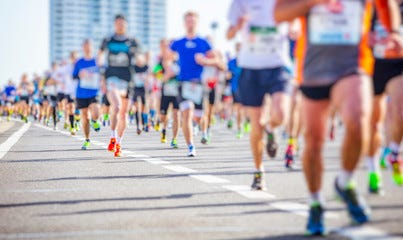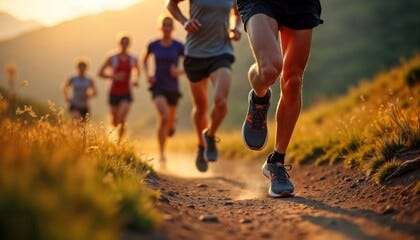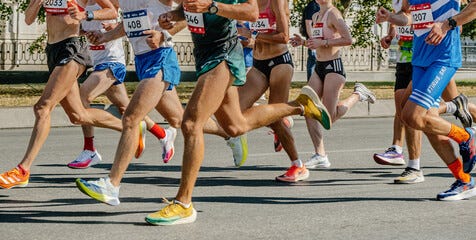I came across a Fox News article recently which illustrated to me just how different the market place for distance running products is today. Comparing it to when I ran at least eight marathons during my twenties, in my peak athletic years of the 1970s.
Wow! Not only has the gear for a marathon evolved, but the inflationary prices over the last 35 years is shocking! Sure, it’s expected in a capitalist economy that product development is inevitable, and I wholeheartedly support it, but I can’t help but wonder a few things regarding what’s listed in the article.
My suspicion is that this was a promo article to stimulate sales by a few of the companies which will benefit, but I can’t help but wonder if some of the gear would be beneficial, as opposed to hindering me in running one, if I had such gear back then.
For starters, the suggested shoes - $250 – almost caused me to fall out of my chair! When I began running road races in 1971, Nike was an infant running shoe company out of Oregon and their recommended shoe for a marathoner then was around $25.00. The sole was decent for taking the impact of 26.2 miles of steady pounding on pavement, while the top lacing part which covered ones upper foot was heavy leather. If I didn’t break them in properly before a marathon, which happened a few times, the blisters would result in either stopping you, or you gritted through it to the finish line, then paid the consequences for a week or two afterwards.
Yes, these new ones are no doubt light and comfortable, but in my mind, I just couldn’t justify paying that much, and they’re now made in either China, or some other country in the far-east.
Ah yes, a GPS watch; at least there is a variety of brand choices offered here! I can’t help but wonder if there are any marathoners left these days who still go by the old analog face with hour, minute and second hands sweeping around, just like the face I’ve chosen on my Apple watch today. The only reason I wear one today at 71 years old is because it was a gift. How ironic! For me, this illustrates how product marketing today lures the potential buyer into thinking how they are going to be faster, and finish more near the front pack of the race, if they buy one. But hey, at least you look trendy and cool!
Next, we find recommended a “Hydration backpack” for holding water, or some liquid of preference. Whatever happened to the tables of water in cups to snatch as you went by; half of it sloshing out all over you as you slurp it. Aaah… that felt good with the air cooling down your sweating body; a bit. Then too, if you carry all the water that goes into the bladder on your back, I wouldn’t want to carry the extra weight it would generate, unless the course went through countryside without tables and cups during the last half. After all, isn’t the point of all this great designed gear to lighten one’s load and make you lighter and more swift?
Then, there’s the chafing balm. Sure, it may have a few ingredients that help to prevent chafing, and heal skin, but ten bucks with tax? That’s what I paid to register for my first marathon! I can’t imagine what that fee is today. If I found I needed it, which was once, I used either Vaseline or suntan lotion. It worked fine. For men, of course, the main issue here is how well their jock holds their package.
A running belt for $16.00 is next on the list of items you really need. Do I need to point out two things I’ve already mentioned; cups of water and chafing? Any novice runner who’s experimented with such gear quickly realizes whether, or not, it’s something they really need when running a 10K, let alone a marathon. Had I tried running a race with that on, I would have probably taken it off and thrown it along the course, hoping it would be there when I tried to retrieve it after the race. Then again, I probably would have just abandoned it.
Next to last on the list is a pair of running shorts. For $70 though, they’d better turn me into a front of the pack competitor! The running shorts I ran with were around $15.00 and made out of nice breezy material that kept me plenty cool. Is the author of this article assuming that only wealthy upper-class people run marathons? I’m just wondering!
Finally, we have arrived at the item one may need – depending on their training regimen in preparation for a marathon – but rarely, if ever, use. Massage equipment! Noticing that it’s listed from Amazon and being under $20.00, it would probably be a good guess that it’s also made in China – like most everything else we buy nowadays – and work for only a few uses.
My experience as one who did plenty of races in my days, I can attest to the high likelihood that it would have been just as painful to use one of these gizmos during the first week after completing a race. So, I’d classify this item as a total waste. Besides, in my honest opinion, the best thing one can do after a race is to gently get out and jog during the first week of recovery, if possible, to work out the lactic acid build up, and excessive strain, in one’s muscle tissue.
So, what are my credentials for justifying this commentary on this subject? In 1977, my personal best was 2 hours, 33 minutes. This time, for the NAIA Div. III track & field times in the nation that year, was second best. That year, it qualified for eight points in the national track & field championships. Only two years prior, I ran the Boston Marathon, just prior to being discharged from the Air Force after four years of service as the Vietnam War was ending. I placed 166th behind Bill Rogers, who won it that year, out of around four thousand entrants. Had I not “hit the wall” and stumbled in over the last four miles of the course, I would have likely placed within the first one hundred finishers and crossed the line under two hours, thirty minutes. Those two races were my last two out of eight total.
If I were competing today, I’d have to have a financial sponsor to support the cost of buying and using such gear. Then again, my personal preference would be to ignore most of it; except maybe the shoes. During my first ever marathon race, I thought I’d chosen good shoes because they were light. At around halfway through, I was developing blisters even though they were nylon except for the sole. Taking them off, I tried running a bit more, but that was on crush coral; not happenin’. Having not finished that one, I didn’t count it as a completion.
But man, did I learn from it!




